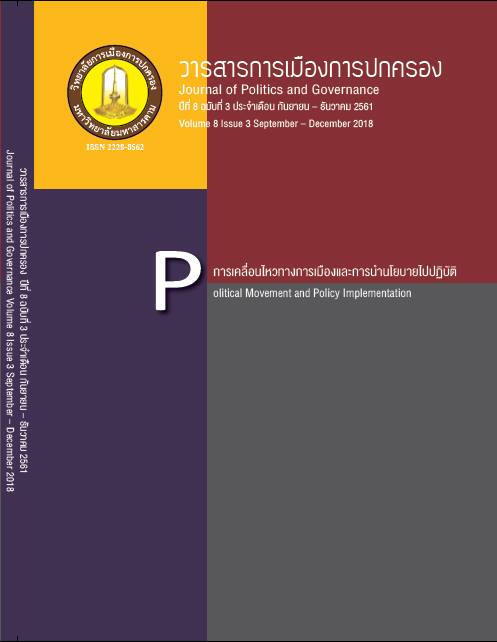The Relations between Thaksin Shinawatra’s Policies and Red-shirt Movement: Looking the Red-shirt Movement in Mahasarakham through Cognitive Mapping
Main Article Content
Abstract
One of the effects of the 2006 coup d'état were the uprising of the Red-Shirts and political conflicts, showing through the polarised politics in Thailand. Also, the Red-Shirts were considered to be the main political supporters of Thaksin Shinawatra. The study, therefore, aimed at investigating the factors leading to being the Red-Shirts and the relations between Thaksin Shinawatra’s policies and the Red-shirt movement, focusing on the case study of the 3 Red-Shirts’ villages in Mahasarakham province. The study employed mixed methods by using 310 questionnaires for the quantitative method and in-depth interviews of the 25 Red-Shirts for the qualitative method. The data gained was, then, analysed by SPSS program and cognitive mapping respectively. The study showed that the factors leading to being the Red-Shirts were Thaksin Shinawatra’s policies, the 2006 coup d'état and the popularity of Thaksin. It was moreover found that Thaksin Shinawatra’s policies could literally improve the Red-Shirts’ quality of life. The policies supporting the claim were the 30 Baht Health Care Scheme and the Farmers’ Debt Repayment Policy. Moreover, Red-shirts have no relationship with sex, age, marital status, education level, career and income of the sample. This is different from the previous study, which aimed to identify whether red-shirts had a factor in their income, occupation and education level.
Article Details
References
ดำรง วัฒนา. (2542). สถิติประยุกต์ สำหรับการวิเคราะห์ข้อมูลทางรัฐประศาสนศาสตร์และรัฐศาสตร์.กรุงเทพฯ: โครงการผลิตตำราและเอกสารประกอบการสอนของคณะรัฐศาสตร์ จุฬาลงกรณ์มหาวิทยาลัย.
นิธิ เอียวศรีวงศ์. (25 สิงหาคมพ.ศ. 2551). การปรับระบบการเมือง. มติชน: 6
ประจักษ์ ก้องกีรติ. (2557). ปาฐกถา ประจักษ์ ก้องกีรติ: เส้นทางแห่งความไม่เสมอภาคในสังคมไทย. Retrieved 15 ธันวาคม 2560, from ประชาไท http://www.prachatai.com/journal/2014/06/54226
ประสงค์ชัย เศรษฐสุรวิชญ์.(2557). การเข้าสู่วาระนโยบายระบบขนส่งทางรางในประเทศไทย: กรณีศึกษาโครงการรถไฟความเร็วสูงโดยใช้ตัวแบบของคิงด็อน. วิทยานิพนธ์รัฐศาสตรมหาบัณฑิต สาขาวิชาการเมืองและการจัดการปกครอง คณะรัฐศาสตร์ จุฬาลงกรณ์มหาวิทยาลัย.
ปิ่นแก้ว เหลืองอร่ามศรีและคณะ. (2555). พัฒนาการจิตสํานึกและปฏิบัติการทางการเมืองของชาวเสื้อแดงในจังหวัดเชียงใหม่.รายงานการวิจัยในชุดโครงการทบทวนภูมิทัศน์การเมืองไทย.กรุงเทพฯ: สํานักงานกองทุนสนับสนุนการสร้างเสริมสุขภาพ (สสส.), แผนงานสร้างเสริมการเรียนรู้กับสถาบันอุดมศึกษาไทย เพื่อการพัฒนานโยบายสาธารณะที่ดี(นสธ.), สถาบันศึกษานโยบายสาธารณะมหาวิทยาลัยเชียงใหม่ (PPSI)
พิชญ์ พงษ์สวัสดิ์. (2549). รัฐธรรมนูญฉบับชั่วคราว ฉบับ ค้างคืน และ ฉบับ ค้างแรม. Retrieved 15 ธันวาคม 2560, from ประชาไท http://www.prachatai.com/journal/ 2006/10/9935
พิชญ์ พงษ์สวัสดิ์. (2557). ก่อนจะถึงยุครัฐธรรมนูญ ฉบับต้านประชาชน. Retrieved 15 ธันวาคม 2560, from มติชน http://www.matichon.co.th/news_detail.php?newsid=1415698651
วรรณวิภางค์ มานะโชติพงษ์. (2557). มองเหลือง-แดง ผ่านขั้วความคิดทางการเมือง. วารสารเศรษฐศาสตร์ธรรมศาสตร์ 32(3), หน้า 31-68.
เวียงรัฐ เนติโพธิ์. (2551). การกระจายอำนาจกับการเมืองท้องถิ่น อำนาจและผลประโยชน์อยู่ที่ใคร? Retrieved 15 ธันวาคม 2560, from ประชาไท http://www.prachatai.com/ journal/2008/02/15809
เวียงรัฐ เนติโพธิ์. (2554). เมื่อชาวอีสานเข้าใจโลกกว้าง รู้จักชนชั้นสูง-คนชั้นล่าง และมีจุดยืนทางการเมือง. Retrieved 15 ธันวาคม 2560, from มติชน http://www.matichon.co.th/ news_detail.php?newsid=1303393309
สมชัย ภัทรธนานันท์ และอัญชลี มณีโรจน์. (แปล). (2555, กรกฎาคม - ธันวาคม).การเมืองของสังคมหลังชาวนา : เงื่อนไขการก่อตัวของคนเสื้อแดงในภาคอีสาน.ฟ้าเดียวกัน. 10 (2). หน้า 76.
สุรีพร คลังพระศรี. (2558).เครือข่ายการสื่อสารการเมืองของกลุ่มแนวร่วมประชาธิปไตยต่อต้านเผด็จการแห่งชาติ (กลุ่มคนเสื้อแดง) ในเขตพื้นที่ภาคตะวันออกเฉียงเหนือ. นิเทศศาสตรปริทัศน์ 19(1), หน้า 224-233.
อภิชาต สถิตนิรมัย นิติ ภควัตรพันธุ์ ยุกติ มุกดาวิจิตร. (2555). ทบทวนภูมิทัศน์การเมืองไทย.กรุงเทพฯ : สำนักงานกองทุนสนับสนุนการสร้างเสริมสุขภาพ (สสส.).
อภิชาต สถิตนิรามัย. (2556). “เหลือง VS แดง: สีของความขัดแย้งทางชนชั้น?” ในชาญวิทย์ เกษตรศิริ บรรณาธิการ. พฤษภา-พฤษภา: สังคมรัฐไทยกับความรุนแรงทางการเมือง. มูลนิธิโครงการตำราสังคมศาสตร์และมนุษยศาสตร์: กรุงเทพ.
อุเชนทร์ เชียงเสน. (2554). “กำเนิด ‘เสื้อแดง’ ในฐานะขบวนการโต้กลับ,” ฟ้าเดียวกัน 9(3), หน้า 122-154.
เอกพลณัฐ ณัฐพัทธนันท์. (2558). การเมืองเสื้อสีกับการศึกษาขบวนการโต้กลับตามจารีตการศึกษาขบวนการทางสังคมและการเมือง. วารสารสังคมศาสตร์ 27(1), หน้า 85-128.
เอนก เหล่าธรรมทัศน์. (2546). สองนคราประชาธิปไตย: แนวทางปฏิรูปการเมือง เศรษฐกิจเพื่อประชาธิปไตย. กรุงเทพฯ: ทิปปิ้ง พอยท์.
ภาษาอังกฤษ
Axelrod, R. (1976). Structure of Decision: The Cognitive Maps of Political Elites. Princeton University Press, Princeton, NJ.
Bunyavejchewin, P. (2010). Constructing the ‘Red’ Otherness: The Role and Implications of
Thainess on Polarised Politics. ASEAS - Austrian Journal of South-East Asian Studies, 3(2), pp. 241-248.
Eden, C. (1988). Cognitive mapping. European Journal of Operational Research, 36(1),
pp. 1-13.
Eden, C., Williams, H., & Smithin, T. (1986). Synthetic wisdom: The Design of a mixed-mode modelling system for organizational decision making. Journal of the Operational Research Society, pp. 233-241.
Ferrara, F. (2015). The Political Development of Modern Thailand. Cambridge: Cambridge University Press.
Gummer, A. (2015). Play: Fun ways to help your child develop in the first five years. London: Penguin Random House.
Jermsittiparsert, K. and M. Kitipatmontree. (2017). Red, yellow, or no shirt: Where do
university students of Thailand stand?. Rangsit J. Soc. Sci. Human., Vol. 4, pp. 43-50.
Keyes, C. F. (2010, November).From Peasant to Cosmopolitan Villagers: Refiguring the ‘Rural’in Northern Thailand. Paper presented at the A special lecture organized by the Anthropology Graduate Program, Thammasat University, Bangkok.
Kosko, B. (1987). Adaptive inference in fuzzy knowledge networks. In Proceedings of the First IEEE International Conference on Neural Networks (ICNN-86), San Diego, CA, pp. 261–268.
Lin, C. S., & Hwang, C. L. (1987). New forms of shape invariants from elliptic Fourier
Descriptors. Pattern recognition, 20(5), pp. 535-545.
Özesmi, U., & Özesmi, S. L. (2004). Ecological models based on people’s knowledge: a multi-step fuzzy cognitive mapping approach. Ecological modelling, 176(1-2), pp. 43-64.
Prapart Pintobtang. 2011. What Makes Thai Villagers “Grass Tip” Uprising after the September 19, 2006 Coup? Chiba: IDE-JETRO.
Siamwalla, A. and Jitsuchon, S. 2012. The Socio-Economic Bases of theRed/Yellow Divide: A Statistical Analysis. in Michael Montesano, Pavin Chachavalpongpun and Aekapal Chongvilaivan (eds). Bangkok May 2010:Perspectives on a Divided Thailand, pp. 64-71.
Srinivas, V., & Shekar, B. (1997). Strategic decision-making processes: network-based representation and stochastic simulation. Decision Support Systems, 21(2), 99-110.
Thabchumpon, N., & Duncan, M. (2011). Urbanized villagers in the 2010 Thai Redshirt
protests. Asian Survey, 51(6), pp. 993-1018.
Tolman, E. C. (1948). Cognitive maps in rats and men. Psychological review, 55(4), p.189. Walker, A. (2010). Thailand’s Farmers Have Stood Up. Wall Street Journal, 19


